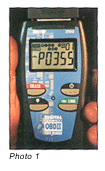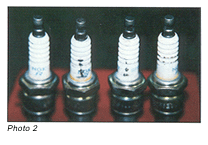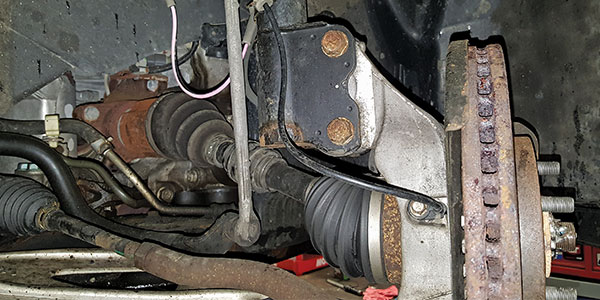As one might expect, the introduction of low-maintenance ignition systems has changed how we sell and service secondary ignition system parts for import vehicles. Most import nameplates have, for example, replaced conventional distributor ignition systems with distributorless or coil-on-plug (COP) ignitions in order to reduce the number of wearing parts in the secondary or high-voltage portion of the ignition system. Unlike distributor ignitions, distributorless and COP secondary ignitions have no distributor rotor or cap to wear out. To further reduce maintenance, the COP design also eliminates the secondary ignition cable itself as a source of high-tension voltage leakage or resistance. Finally, better oil and fuel control in modern engines, combined with modern long-life spark plugs, has increased the reliability of secondary ignition systems to the point that secondary ignition maintenance has become a scheduled, rather than a "failure-based," maintenance item.
SCHEDULED MAINTENANCE
In most import applications, secondary ignition system maintenance is recommended at either 30,000- or 100,000-mile intervals. Too often, however, many owners feel that their import doesn’t need a "tune-up" or secondary ignition system maintenance as long as it feels like it’s "running good."

In reality, spark plugs eventually develop high electrical resistance because the electrodes wear away. When this happens, the secondary ignition voltage will increase until the ignition coil, ignition cable, spark plug boot or spark plug develops a high-voltage leak. When a high-voltage leak does occur, the cylinder misfires and causes a diagnostic trouble code (DTC) to be stored in the powertrain control module’s (PCM’s) diagnostic memory. The vehicle’s orange "malfunction indicator light" (MIL) will then illuminate, which usually brings the customer to an independent import repair shop for service.
With that scenario in mind, a service writer should remember that premature spark plug and secondary ignition wear often occurs when import vehicles are driven at high engine loads and speeds. Moreover, even when a misfire hasn’t occurred, damp or salt-water environments may cause the spark plugs to seize in the cylinder heads if they’re not replaced at regular intervals. In some cases, the spark plug seizing to the cylinder head will damage the cylinder head threads to the degree that the head must be removed for repair or replacement. Consequently, a service writer should recommend secondary ignition service at intervals commensurate with his regional environment and nameplate experience.
DIAGNOSTIC OVERVIEW
What happens when a secondary ignition failure occurs on a 1996 and newer import vehicle? First of all, OBD II regulations require a PCM to monitor an engine for misfires under all positive load and speed conditions. The PCM detects misfires by measuring small decelerations in crankshaft speed. Second, it’s also important to remember that the initial crop of imports had different misfire detection strategies than later imports. A 1996 model, for example, may turn on the MIL if a spark plug wire is shorted at idle. A later model may turn on the MIL only after the engine reaches a specific speed, temperature and load.
Because many misfire monitors on the early OBD II imports were too sensitive, they turned on the MIL when a misfire didn’t really exist. To illustrate, driving a vehicle with a manual transmission on a washboard road may create unusual decelerations in the crankshaft that would cause a false misfire DTC to be stored in the PCM’s diagnostic memory. Later misfire detection strategies have become much more application-specific and are designed to turn on the MIL only when an engine misfire is detected during specific engine speeds and loads.
MISFIRE CODES
When diagnosing a misfire trouble code, remember that different scan tools may produce different misfire codes. A misfire may appear as a DTC P0300 (random misfire) on one scan tool, while the same misfire may appear as a DTC P0301 (misfire on cylinder #1) and P0304 (misfire on cylinder #4) on another scan tool. To eliminate this issue, a professional, "full-function" scan tool should be used – one that includes a misfire table that will enumerate the number of misfires occurring on each cylinder.
Keep in mind that misfires may also be caused by mechanical failures such as a faulty fuel injector, vacuum leak, broken valve train part or low cylinder compression. When diagnosing multiple misfires on V-type engines, remember that an out-of-time camshaft will cause misfires of equal intensity on that particular cylinder bank.
Misfires are classified into type "A" and type "B" categories. The excess hydrocarbons and oxygen generated by a catalyst-threatening, "one-trip," type-A misfire will melt the catalyst by driving catalytic converter temperatures over 1,800° F. The type A misfire will also cause the MIL to flash once per second, within 200 revolutions of when the misfire occurs. This warns the driver that immediate attention is required to remedy a potentially catalyst-damaging misfire condition.
The "two-trip" type-B misfire, on the other hand, is one that causes exhaust emissions to exceed Federal Test Procedure (FTP) exhaust emissions standards by at least 150 percent, but will not damage the catalytic converter. Keeping in mind that the specific methods of counting misfires have changed among the various nameplates since full-function OBD II was introduced in 1996, suffice it to say that the PCM generally determines whether or not the misfire is a type A or B by counting the number of misfires per 1,000 engine revolutions.
IGNITION COILS
Distributorless and COP ignition coils require slightly different diagnostic techniques. First, remember that distributorless ignitions use a single coil to fire two cylinders. Consequently, an ignition coil failure on a distributorless ignition will normally cause a misfire code to be stored for each of its two cylinders.
COP ignitions, on the other hand, mount an ignition coil on top of each spark plug. Consequently, an ignition coil failure on a COP configuration usually results in a misfire DTC being stored for a single, rather than multiple, cylinders.
Newer OBD II misfire detection systems are also becoming much more failure-specific. In Photo 1 on page 14, for example, a DTC P0355 is being displayed, which means that the PCM has detected a loss of primary current flow to the #5 or "E" coil-on-plug. Since each nameplate has its own ignition and misfire detection configurations, this particular "generic" DTC may or may not be displayed if primary current is disrupted to the coil-on plug.

IGNITION WIRES
The advent of the low-maintenance ignition has changed the role of the common secondary ignition wire. To illustrate, some auto manufacturers now include spark plug wire replacement as a scheduled maintenance item to prevent a catalyst-damaging misfire from taking place. Second, spark plug wires usually stretch or tear when removed at 100,000-mile intervals. Since spark plug and plug wire access is so difficult on many new applications, recommending that the wires be replaced along with the spark plugs is a good preventive maintenance procedure. Otherwise, a damaged wire may cause a misfire issue weeks, and perhaps months, after the spark plugs are replaced.
SPARK PLUGS
Installing the correct spark plug is much more important with OBD II vehicles than with the older pre-1996 OBD I vehicles. While the 30,000-mile replacement interval usually requires a standard spark plug, the 100,000-mile interval requires a long-life, platinum-type spark plug electrode with the threads rolled and plated to prevent seizure in the cylinder head. In addition, some import nameplates require special electrode configurations. Substituting standard or "specialty" spark plugs in long-life, OBD II applications may cause premature electrode wear, possible thread seizing problems or a troublesome misfire problem.
Most important, cleanliness is imperative when installing long-life spark plugs. Conductive contamination from fingerprints and oil may cause carbon tracking (See Photo 2, center spark plugs). When carbon tracking occurs on the spark plug, an identical trace is etched into the spark plug wires or coil-on-plug insulator boot, which means that both parts must be replaced to prevent a repeat failure.
MARKET VALUES
Although secondary ignition parts replacements have become less frequent, the skill value of the related diagnostics and the replacement times of the parts themselves has doubled, or perhaps tripled, during the last decade. Although the price of secondary ignition service has become a "shocking" development for import owners, it also has become a preventive maintenance gold mine for import specialists learning to service and sell leading-edge import technology.





